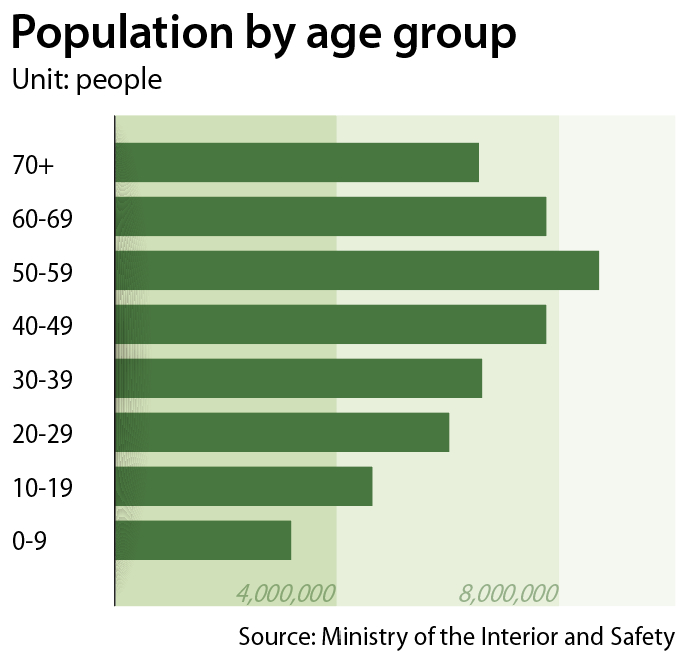Korea has more 60-year-olds than 40-year-olds for first time on record
Published: 04 Oct. 2024, 17:35
Updated: 04 Oct. 2024, 18:30
-

- SHIN HA-NEE
- shin.hanee@joongang.co.kr
![Pedestrians stroll near Tapgol Park in central Seoul on Friday. [NEWS1]](https://koreajoongangdaily.joins.com/data/photo/2024/10/04/e73ccfa1-6927-4c9d-acf8-35979ab5145d.jpg)
Pedestrians stroll near Tapgol Park in central Seoul on Friday. [NEWS1]
Individuals in their 60s became the second-largest age group in Korea, surpassing those in their 40s for the first time ever, in a time of rapid aging and an ultralow birthrate.
The number of individuals aged 60 to 69 reached 7.77 million as of the end of September, according to data compiled by the Ministry of the Interior and Safety, outnumbering those in their 40s — who totaled 7.769 million, by 1,214 people — for the first time since the ministry began compiling the relevant data in 2008.
People 50 to 59, tallying 8.72 million, came in at No. 1.
The Korean population's average age was 45.2 as of September, up from 44.6 a year earlier.
As the Korean population continues to age rapidly, with fertility having hit an all-time low of 0.72 children per woman last year, the number of people aged 65 years or older surpassed the 10 million mark for the first in July.

In a report released Sept. 23, Statistics Korea projected that adults aged 65 and older — who currently encompass 19.2 percent of the nation — would make up 47.7 percent of Korea's population by 2072, while the global average is estimated to rise from 10.2 percent to 20.2 percent. Korea's median age will rise from 46.1 to 63.4 by 2072, whereas the global average will grow from 30.6 to 39.2.
Cancer, heart disease and pneumonia were the top three causes of death last year, taking up 41.9 percent of total fatalities, according to an annual report the statistics agency released the same day.
Total deaths declined 5.5 percent on year to 352,511 in 2023, the first decrease since 2019, mainly due to the decline of Covid-19 severity.
Cancer remained the leading cause of death by a significant margin, accounting for 85,271 deaths last year. The cancer mortality rate stood at 166.7 per 100,000 people, up by 4.0 from the previous year.
Covid-19, previously No. 3 on the list, fell to the 10th place.
Notably, the suicide rate rose 8.5 percent on year last year to 27.3 per 100,000 people, accounting for 13,978 deaths. Suicide was the No. 5 cause of death following cerebrovascular disease.
The report marks the first time since 2021 that the suicide rate has taken an upturn. The statistics agency cited "social isolation and economic struggles” aggravated by Covid-19 for the yearly increase.
Korea's age-standardized suicide rate of 24.8 per 100,000 people far outpaced those of other Organisation for Economic Cooperation and Development (OECD) nations. Korea was the only country with a suicide rate over the 20 threshold, with the OECD average standing at 10.7.
BY SHIN HA-NEE [shin.hanee@joongang.co.kr]










with the Korea JoongAng Daily
To write comments, please log in to one of the accounts.
Standards Board Policy (0/250자)